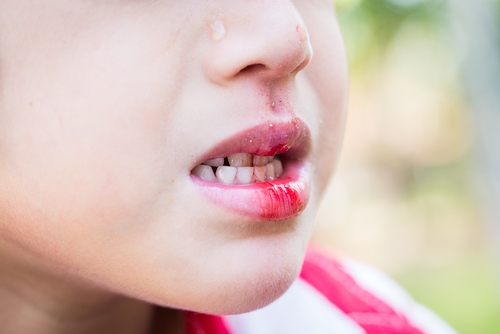Almost 50% of children will have some type of injury to a tooth during childhood, most of which are preventable. Mouth and tooth injuries are common, and occur after a fall, car accident, sports injury or fight. In most cases, these injuries are not life threatening, and rarely lead to serious complications, but they can have long-lasting effects of the child’s appearance and self-confidence.
When to Seek Help
Children with any of the following symptoms should be evaluated by a healthcare provider (dentist, paediatrician or emergency department):
- If there is pain, tenderness, or sensitivity (to hot, cold or pressure) in a tooth
- If there is a broken, loose, or missing tooth after trauma (the tooth could have been inhaled or swallowed)
- If there is bleeding that does not stop after applying pressure for 10 minutes
- If there is pain in the jaw when opening or closing the mouth
- If there is difficulty swallowing or breathing
- If there is an object stuck in the roof of the mouth, cheek, tongue, or throat
- If there is a large or gaping cut inside the mouth or on the face
- If the child could have a puncture in the back of the throat
- If there is a cut on the lip that extends through the lip’s border into the surrounding skin
- If the child is weak, numb, or has blurred vision or slurred speech
- if the parent is concerned about the child’s condition
- If the child develops a fever or other signs of infection after a mouth or tooth injury (localized redness, pus, increasing pain); signs of more serious infection may include neck pain or stiffness, inability to open the mouth completely, drooling, or chest pain.
Treatment
The treatment for injuries depends on the type of injury and whether the injured tooth is a primary (baby) tooth or a permanent (adult) tooth.
Dislocated or loose primary tooth – this is the most common injury and the management usually involves preventing future damage to the permanent teeth.
Broken primary tooth – children with broken teeth should see a dentist. The dentist will determine if the tooth’s nerves or blood vessels could be damaged. Treatment may include smoothing the rough edges of the tooth, rebuilding the tooth with a resin material, or sometimes removing the tooth.
Dislocated permanent tooth – this constitutes a dental emergency. The tooth should be placed back in to the socket as soon as possible, and if unable tooth, the tooth should be stored in milk and brought to the dentist for re-implantation. If milk is not available, the tooth could be stored in a container with the child’s saliva. Do NOT store the tooth in water.
Loose permanent tooth – this constitutes a dental emergency. In most cases, the tooth can be returned to its correct position and monitored over time.
Broken permanent tooth – this can usually be repaired successfully. For the best possible outcome, the child should see a dentist within two days from the time of the injury. Tooth fragments should be saved, if possible, and stored in water as they can sometimes be reattached.
Tears – small wounds or tears inside the mouth usually do not require stitches. Large cuts to the tongue may require stitches as do outer parts of the lips, especially if they extend into the skin.
Puncture wounds – if an object penetrates the mouth, the child should be taken to emergency since the object could have penetrated and require imaging or even surgery.
Home Management
Minor injuries can often bleed. To stop the bleeding, press the area and hold for several minutes.
Pain relief – if a child has pain related to a mouth or tooth injury, the child can apply a piece of ice or frozen popsicle to the area. An over-the-counter pain medication (ibuprofen or acetaminophen) may be given. Follow dose directions on the bottle.
Antibiotics – antibiotics are often not required for dental or mouth injuries. However, if the injury is severe, the dentist or doctor may prescribe antibiotics to prevent infection.
Home care – continue to keep the area clean though be gentle near the injury to prevent further injury or pain. A soft diet can be helpful if a tooth is loose or the mouth is sore. If stitches were placed, avoid spicy or salty food, popcorn and straws for about one week.
Potential Complications
Most children recover completely from mouth and dental injuries. In a small number of cases, complications can occur, including:
- Damage to the permanent teeth – discolouration, sensitivity to hot and cold, damage to nerve (requiring a root canal treatment), or tooth loss
- Scarring – scarring can occur if the wound to the lip was large or crossed into the skin
- Infection – to teeth, gums, and deep spaces of the neck and chest
- Excessive bleeding – this is not common but may occur if there is injury to a major blood vessel
Prevention
Children should be taught to sit while eating and drinking, and to not put anything in their mouth other than food or drink.
One of the easiest ways to reduce the chances of mouth and dental injuries during recreational and sports activities is to have the child wear a mouthguard. A sports guard or a mouthguard is custom made for your child by your dentist by taking impressions of your child’s teeth and fabricating a mouthguard that fits your child precisely. Call our office for more information.


